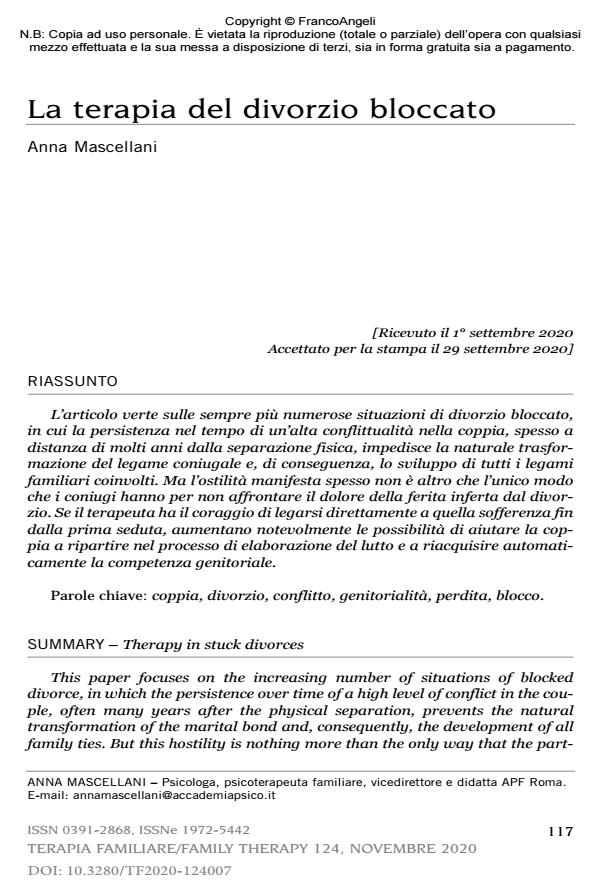Therapy in stuck divorces
Journal title TERAPIA FAMILIARE
Author/s Anna Mascellani
Publishing Year 2021 Issue 2020/124 Language Italian
Pages 26 P. 117-142 File size 126 KB
DOI 10.3280/TF2020-124007
DOI is like a bar code for intellectual property: to have more infomation
click here
Below, you can see the article first page
If you want to buy this article in PDF format, you can do it, following the instructions to buy download credits

FrancoAngeli is member of Publishers International Linking Association, Inc (PILA), a not-for-profit association which run the CrossRef service enabling links to and from online scholarly content.
This paper focuses on the increasing number of situations of blocked divorce, in which the persistence over time of a high level of conflict in the couple, often many years after the physical separation, prevents the natural transformation of the marital bond and, consequently, the development of all family ties. But this hostility is nothing more than the only way that the partners have to avoid facing the pain of the wound inflicted by the divorce. If the therapist has the courage to connect directly to that suffering from the first session, the chances of helping the couple restart in the grieving process and automatically regain parental competence are greatly increased.
Keywords: Couple, divorce, conflict, parenting, loss, deadlock.
- Henderson C.E., Hayslip B., Sanders L.M., Loudon L. (2009). Grandmother-grandchild relationship quality predicts psychological adjustment among youth from divorced families. Journal of Family Issues, 30: 1245-1264.
- Holmes T.H., Rahe R.H. (1967). The Social Readjustment Rating Scale. Journal of Psychosomatic Research, 11(2):213-8. DOI: 10.1016/0022-3999(67)90010-4
- King V. (2003). The legacy of a grandparent’s divorce: Consequences for ties between grandparents and grandchildren. Journal of Marriage and Family, 65: 170-183.
- Laumann-Billings L., Emery R.E. (2000). Distress among young adults from divorced families. Journal of Family Psychology, 14: 671-687. DOI: 10.1037/0893-3200.14.4.67
- Marquardt E. (2005). Between Two Words: the Inner Lives of Children of Divorce. New York: Crown Publishers.
- Mcgoldrick M., Heiman M., Carter B. (1993). I mutamenti nel ciclo vitale della famiglia: una prospettiva sulla normalità. In: Walsh F. (ed.) (1995). Ciclo vitale e dinamiche familiari. Milano: FrancoAngeli.
- McHale J.P. (2009) La sfida della co-genitorialità Milano: Raffaello Cortina.
- Najman J.M., Behrens B.C., Andersen M., Bor W., O’Callaghan M., Williams G.M. (1997). Impact of family type and family quality on child behavior problems: A longitudinal study. Journal of the American Academy of Child e Adolescent Psychiatry, 36(10): 1357-1365. DOI: 10.1097/00004583-199710000-0001
- Sbarra D.A., Emery R.E. (2005). The emotional sequelae of nonmarital relational relationship dissolution: Analysis of change and intrindividual variability over time. Personal Relationships, 12: 213-232.
- Scabini E., Cigoli V. (2000). Il famigliare. Milano: Raffaello Cortina.
- Wallerstein J.S., Lewis J.M. (2004). The unexpected legacy of divorce: Report of a 25-year study. Psychoanalytic Psychology, 21: 353-370. DOI: 10.1037/0736-9735.21.3.35
- Williamson D.S. (1982). La conquista dell’autorità personale nel superamento del confine gerarchico intergenerazionale. Terapia Familiare, 11: 77-93.
- Ahrons C.R. (2007). Family ties after divorce: Long term implications for children. Family Process, 46(1): 53-65.
- Amato P.R. (2000). The consequences of divorce for adults and children. Journal of Marriage and Family, 62: 1269-1287.
- Amato P.R. (2010). Research on divorce: Continuing trends and new developments. Journal of Marriage and Family, 72: 650-666.
- Andolfi M. (2015). La terapia familiare multigenerazionale. Milano: Raffaello Cortina.
- Andolfi M., D’elia A. (a cura di) (2007). Le perdite e le risorse della famiglia. Milano: Raffaello Cortina.
- Andolfi M., Mascellani A. (2019). Intimità di coppia e trame familiari. Milano: Raffaello Cortina.
- Arditti J.A., Prouty A.M. (1999). Change, disengagement and renewal: Relationship dynamics between young adults and their fathers after divorce. Journal of Marital and Family Therapy, 25: 61-81.
- Bohannan P. (1973). The six stations of divorce. In: Lasswell M.E., Lasswell T.E. (eds.), Love Marriage and Family: a developmental approach. Illinois: Scott & C.
- Boszormenyi-Nagi I., Spark G. (1973). Invisible loyalties. New York: Harper & Row.
- Bowen M. (1979). Dalla famiglia all’individuo. La differenziazione del sé nel sistema familiare. Roma: Astrolabio.
- Caillé P. (1995). Les situations bloquées du divorce. Une approche systémique. Thérapie Familiale, 16(4): 351-366.
- Carrozza V. (2012). La sindrome del criceto. -- Sito www.rivieraweb.it
- Carter D.K. (2014). Coordinazione genitoriale. Una guida pratica per i professionisti del diritto di famiglia. Milano: FrancoAngeli.
- Cigoli V. (2017). Clinica del divorzio e della famiglia ricostruita. Bologna: Il Mulino.
- Cigoli V., Galimberti C., Mombelli M. (1988). Il legame disperante. Il divorzio come dramma di genitori e figli. Milano: Raffaello Cortina.
- Cummings E.M., Davies P.T. (2010). Marital Conflict and Children. En emotional Security Perspective. New York: Guilford Press (trad. it.: Zaccagnini C., Zavattini G.C. (a cura di) (2013). Il conflitto coniugale e i figli. Roma: Borla).
- Emery R. (2008). La verità sui figli e il divorzio. Gestire le emozioni per crescere insieme. Milano: FrancoAngeli.
Anna Mascellani, La terapia del divorzio bloccato in "TERAPIA FAMILIARE" 124/2020, pp 117-142, DOI: 10.3280/TF2020-124007